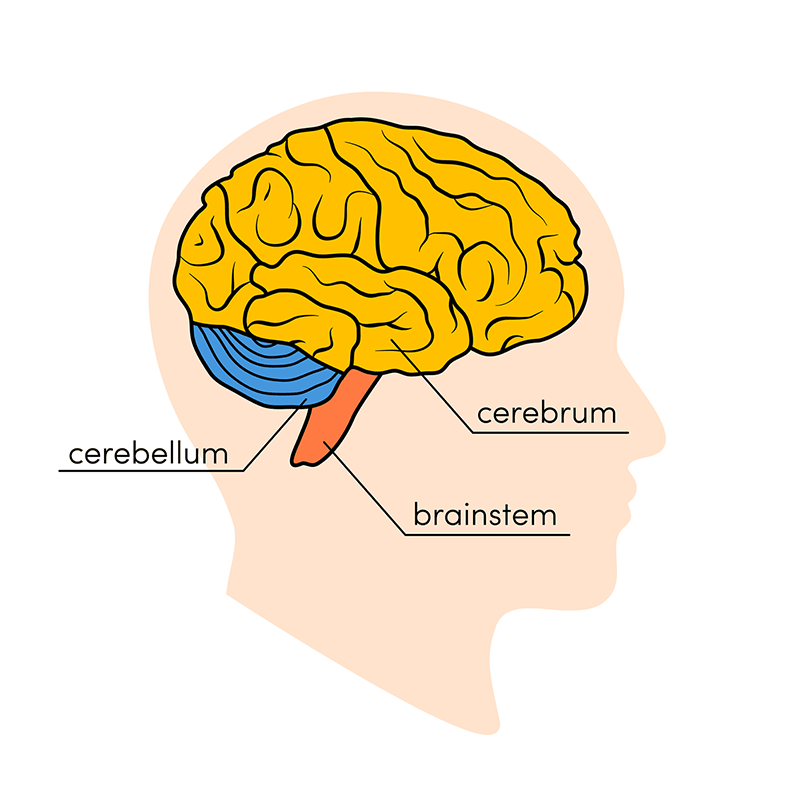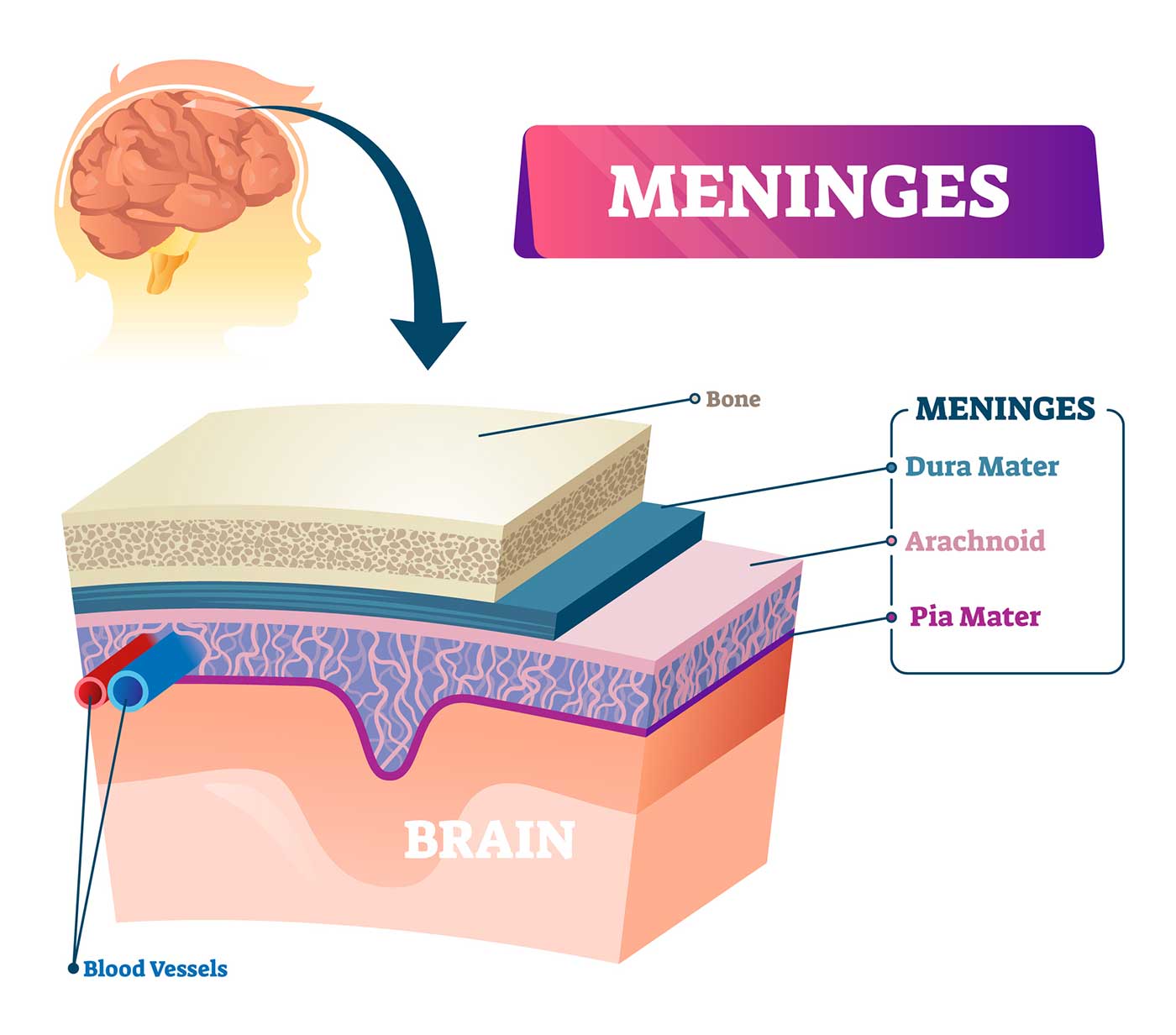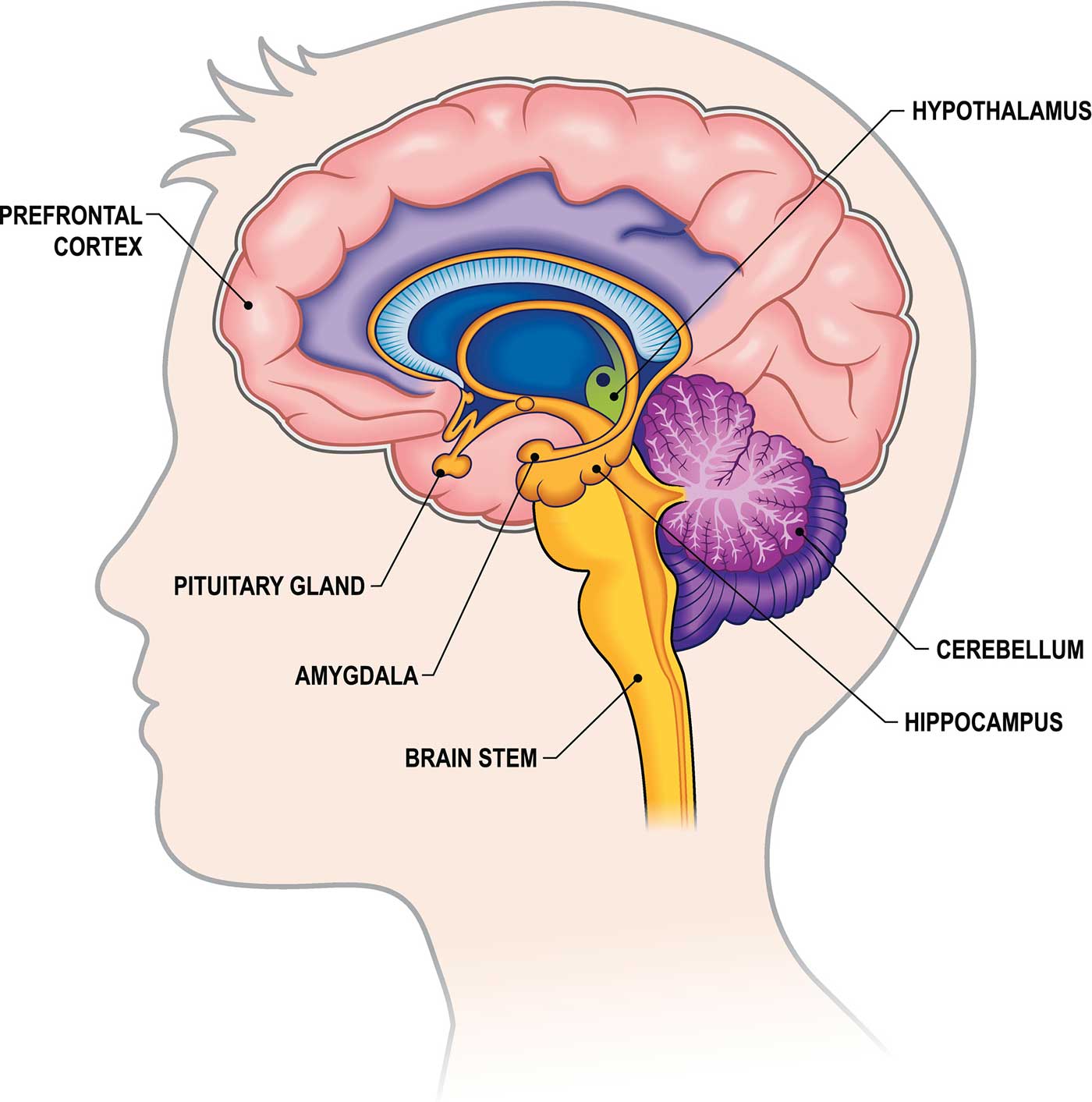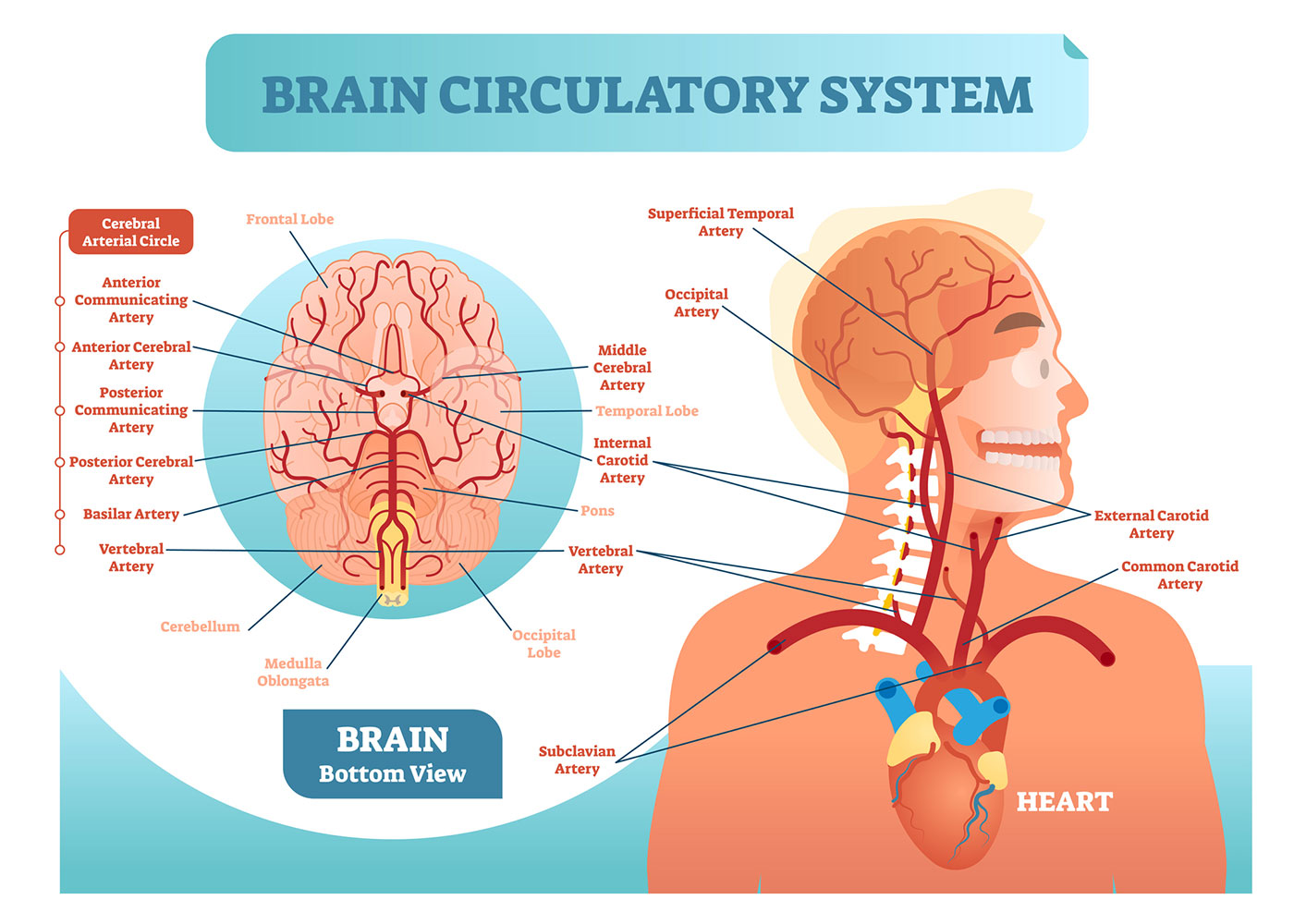Easy Way to Remember What Each Lobe of the Brain Does
What is the brain?
The brain is a complex organ that controls thought, memory, emotion, touch, motor skills, vision, animate, temperature, hunger and every process that regulates our trunk. Together, the brain and spinal cord that extends from it make up the central nervous arrangement, or CNS.
What is the brain fabricated of?
Weighing nigh 3 pounds in the average adult, the brain is about 60% fat. The remaining 40% is a combination of water, poly peptide, carbohydrates and salts. The brain itself is a not a muscle. It contains blood vessels and nerves, including neurons and glial cells.
What is the grey matter and white matter?
Gray and white matter are two dissimilar regions of the central nervous system. In the brain, greyness matter refers to the darker, outer portion, while white matter describes the lighter, inner section underneath. In the spinal cord, this order is reversed: The white matter is on the exterior, and the gray thing sits inside.

Gray affair is primarily composed of neuron somas (the round fundamental prison cell bodies), and white matter is more often than not made of axons (the long stems that connects neurons together) wrapped in myelin (a protective coating). The dissimilar composition of neuron parts is why the 2 appear as carve up shades on sure scans.

Each region serves a different role. Gray matter is primarily responsible for processing and interpreting data, while white thing transmits that information to other parts of the nervous organisation.
How does the brain work?
The brain sends and receives chemic and electric signals throughout the body. Different signals control different processes, and your brain interprets each. Some make y'all feel tired, for example, while others make you feel pain.
Some messages are kept within the encephalon, while others are relayed through the spine and across the body's vast network of nerves to distant extremities. To do this, the central nervous system relies on billions of neurons (nerve cells).
Main Parts of the Brain and Their Functions
At a loftier level, the brain can be divided into the cerebrum, brainstem and cerebellum.

Cerebrum
The cerebrum (front of brain) comprises gray thing (the cerebral cortex) and white affair at its eye. The largest role of the encephalon, the cerebrum initiates and coordinates motion and regulates temperature. Other areas of the cerebrum enable oral communication, judgment, thinking and reasoning, problem-solving, emotions and learning. Other functions relate to vision, hearing, touch and other senses.
Cerebral Cortex
Cortex is Latin for "bawl," and describes the outer gray thing roofing of the cerebrum. The cortex has a large surface expanse due to its folds, and comprises about half of the brain'southward weight.
The cerebral cortex is divided into two halves, or hemispheres. It is covered with ridges (gyri) and folds (sulci). The two halves join at a large, deep sulcus (the interhemispheric fissure, AKA the medial longitudinal fissure) that runs from the front end of the caput to the dorsum. The right hemisphere controls the left side of the body, and the left half controls the right side of the trunk. The 2 halves communicate with one another through a big, C-shaped structure of white affair and nervus pathways chosen the corpus callosum. The corpus callosum is in the middle of the cerebrum.
Brainstem
The brainstem (middle of brain) connects the cerebrum with the spinal cord. The brainstem includes the midbrain, the pons and the medulla.
- Midbrain. The midbrain (or mesencephalon) is a very complex structure with a range of different neuron clusters (nuclei and colliculi), neural pathways and other structures. These features facilitate diverse functions, from hearing and motion to computing responses and environmental changes. The midbrain besides contains the substantia nigra, an area affected by Parkinson's disease that is rich in dopamine neurons and function of the basal ganglia, which enables movement and coordination.
- Pons. The pons is the origin for four of the 12 cranial nerves, which enable a range of activities such as tear production, chewing, blinking, focusing vision, residue, hearing and facial expression. Named for the Latin discussion for "bridge," the pons is the connectedness between the midbrain and the medulla.
- Medulla. At the bottom of the brainstem, the medulla is where the encephalon meets the spinal string. The medulla is essential to survival. Functions of the medulla regulate many bodily activities, including heart rhythm, animate, blood flow, and oxygen and carbon dioxide levels. The medulla produces reflexive activities such as sneezing, vomiting, cough and swallowing.
The spinal string extends from the lesser of the medulla and through a large opening in the bottom of the skull. Supported past the vertebrae, the spinal string carries messages to and from the encephalon and the remainder of the body.
Cerebellum
The cerebellum ("niggling brain") is a fist-sized portion of the brain located at the back of the head, below the temporal and occipital lobes and higher up the brainstem. Similar the cerebral cortex, information technology has two hemispheres. The outer portion contains neurons, and the inner area communicates with the cerebral cortex. Its office is to coordinate voluntary muscle movements and to maintain posture, balance and equilibrium. New studies are exploring the cerebellum's roles in idea, emotions and social behavior, as well as its possible interest in addiction, autism and schizophrenia.
Brain Coverings: Meninges
Three layers of protective covering chosen meninges surroundings the encephalon and the spinal cord.
- The outermost layer, the dura mater, is thick and tough. It includes 2 layers: The periosteal layer of the dura mater lines the inner dome of the skull (cranium) and the meningeal layer is below that. Spaces between the layers allow for the passage of veins and arteries that supply claret flow to the encephalon.
- The arachnoid mater is a thin, weblike layer of connective tissue that does not incorporate fretfulness or blood vessels. Below the arachnoid mater is the cerebrospinal fluid, or CSF. This fluid cushions the unabridged primal nervous system (encephalon and spinal cord) and continually circulates around these structures to remove impurities.
- The pia mater is a thin membrane that hugs the surface of the brain and follows its contours. The pia mater is rich with veins and arteries.

Lobes of the Encephalon and What They Control
Each encephalon hemisphere (parts of the cerebrum) has four sections, called lobes: frontal, parietal, temporal and occipital. Each lobe controls specific functions.

- Frontal lobe. The largest lobe of the brain, located in the front of the caput, the frontal lobe is involved in personality characteristics, controlling and movement. Recognition of smell commonly involves parts of the frontal lobe. The frontal lobe contains Broca'due south area, which is associated with speech ability.
- Parietal lobe. The middle function of the brain, the parietal lobe helps a person identify objects and understand spatial relationships (where i'southward body is compared with objects around the person). The parietal lobe is also involved in interpreting pain and touch in the body. The parietal lobe houses Wernicke's area, which helps the brain understand spoken linguistic communication.
- Occipital lobe. The occipital lobe is the back part of the brain that is involved with vision.
- Temporal lobe. The sides of the brain, temporal lobes are involved in curt-term retentivity, oral communication, musical rhythm and some caste of odor recognition.
Deeper Structures Within the Brain
Pituitary Gland
Sometimes called the "chief gland," the pituitary gland is a pea-sized structure institute deep in the brain behind the bridge of the nose. The pituitary gland governs the function of other glands in the body, regulating the flow of hormones from the thyroid, adrenals, ovaries and testicles. Information technology receives chemical signals from the hypothalamus through its stalk and blood supply.
Hypothalamus
The hypothalamus is located above the pituitary gland and sends it chemical messages that control its function. It regulates body temperature, synchronizes sleep patterns, controls hunger and thirst and as well plays a office in some aspects of memory and emotion.
Amygdala
Small, almond-shaped structures, an amygdala is located under each half (hemisphere) of the brain. Included in the limbic system, the amygdalae regulate emotion and retention and are associated with the brain's reward system, stress, and the "fight or flight" response when someone perceives a threat.
Hippocampus
A curved seahorse-shaped organ on the underside of each temporal lobe, the hippocampus is part of a larger construction called the hippocampal germination. It supports memory, learning, navigation and perception of space. Information technology receives data from the cognitive cortex and may play a part in Alzheimer'south disease.
Pineal Gland
The pineal gland is located deep in the brain and attached by a stem to the top of the third ventricle. The pineal gland responds to light and night and secretes melatonin, which regulates circadian rhythms and the sleep-wake cycle.
Ventricles and Cerebrospinal Fluid
Deep in the encephalon are four open areas with passageways between them. They also open into the fundamental spinal culvert and the area beneath arachnoid layer of the meninges.
The ventricles industry cerebrospinal fluid, or CSF, a watery fluid that circulates in and effectually the ventricles and the spinal string, and betwixt the meninges. CSF surrounds and cushions the spinal cord and encephalon, washes out waste and impurities, and delivers nutrients.

Claret Supply to the Brain
2 sets of blood vessels supply blood and oxygen to the brain: the vertebral arteries and the carotid arteries.
The external carotid arteries extend upward the sides of your neck, and are where you can feel your pulse when you lot touch on the area with your fingertips. The internal carotid arteries branch into the skull and circulate claret to the front part of the brain.
The vertebral arteries follow the spinal column into the skull, where they join together at the brainstem and form the basilar artery, which supplies blood to the rear portions of the brain.
The circumvolve of Willis, a loop of claret vessels well-nigh the lesser of the brain that connects major arteries, circulates blood from the front of the brain to the back and helps the arterial systems communicate with one some other.

Cranial Fretfulness
Inside the cranium (the dome of the skull), there are 12 fretfulness, called cranial nerves:
- Cranial nerve 1: The first is the olfactory nerve, which allows for your sense of smell.
- Cranial nerve ii: The optic nervus governs eyesight.
- Cranial nervus 3: The oculomotor nerve controls pupil response and other motions of the eye, and branches out from the area in the brainstem where the midbrain meets the pons.
- Cranial nerve 4: The trochlear nervus controls muscles in the center. It emerges from the back of the midbrain part of the brainstem.
- Cranial nerve five: The trigeminal nerve is the largest and virtually complex of the cranial nerves, with both sensory and motor function. Information technology originates from the pons and conveys sensation from the scalp, teeth, jaw, sinuses, parts of the oral fissure and face to the brain, allows the function of chewing muscles, and much more.
- Cranial nerve 6: The abducens nerve innervates some of the muscles in the eye.
- Cranial nerve 7: The facial nervus supports face motility, taste, glandular and other functions.
- Cranial nerve eight: The vestibulocochlear nerve facilitates balance and hearing.
- Cranial nervus 9: The glossopharyngeal nerve allows taste, ear and pharynx movement, and has many more than functions.
- Cranial nerve 10: The vagus nerve allows sensation around the ear and the digestive organization and controls motor activity in the eye, pharynx and digestive system.
- Cranial nerve 11: The accessory nerve innervates specific muscles in the head, neck and shoulder.
- Cranial nerve 12: The hypoglossal nerve supplies motor activity to the natural language.
The first two nerves originate in the cerebrum, and the remaining ten cranial nerves emerge from the brainstem, which has three parts: the midbrain, the pons and the medulla.
Source: https://www.hopkinsmedicine.org/health/conditions-and-diseases/anatomy-of-the-brain
Post a Comment for "Easy Way to Remember What Each Lobe of the Brain Does"